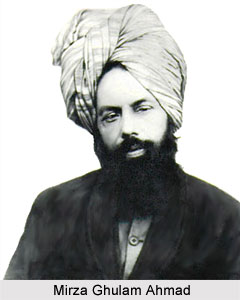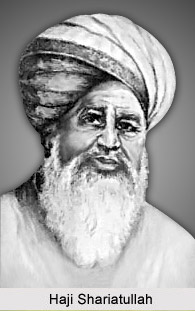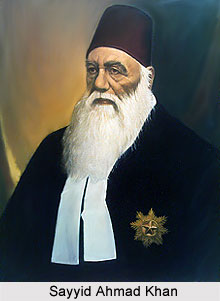 The Muslim socio-religious movements in India were mainly aimed at purifying the religion. The most important socio-religious movements related to Islam religion include the Ahmadiyya movement, the Faraizi movement, the Tariqah-i-Muhammadiyah movement, the Aligarh movement, etc. The Muslim socio-religious movements drew upon the dynamics of the society for the motivation of the Muslims.
The Muslim socio-religious movements in India were mainly aimed at purifying the religion. The most important socio-religious movements related to Islam religion include the Ahmadiyya movement, the Faraizi movement, the Tariqah-i-Muhammadiyah movement, the Aligarh movement, etc. The Muslim socio-religious movements drew upon the dynamics of the society for the motivation of the Muslims.
The Ahmadiyya movement is considered one of the most influential and important Muslim socio-religious movements in India. The movement was started by Mirza Ghulam Ahmad in Punjab. He was a well educated and literate person and he started to proclaim a mission as Masih Maw`ud (promised Messiah), restorer and Mahdi (guide). He also claimed that he was endowed with the powers of prophethood. The main targets of the Ahmadiyya movement were a few well-known Sunni Ulama of the Deoband and the Ahl-i Hadith movements that were increasingly influential among Sunnis in the region. Mirza Ghulam Ahmad also strongly spoke against the increasing influence of the Christian missionaries in Punjab and its surrounding areas. Mirza Ghulam Ahmad and his followers described them as a distinct religious community. They also claimed themselves to be the only upholders of `true Islam`.
 Another significant Muslim socio-religious movement was the Faraizi movement. This religious reform movement was founded by Haji Shariatullah during the nineteenth century. The main objective of the Faraizi movement was to implement and impose the mandatory religious duties ordained by Allah. According to Hazi Shariatullah, it is the responsibility of the Faraizis to assimilate every religious duty legislated by the Holy Quran and the Sunnah of the Prophet. Shariatullah was deeply shocked by the improper beliefs and behaviour among the Muslims in India. His message to the Muslims was to purify the religion and he called for a return to faraiz (the obligatory duties of Islam), specifically the profession of faith (kalimah). He urged the Muslims to attend daily prayers (salat or namaz), fast during Ramadan (sawm or rozah), pay the poor tax (zakat) and also go to pilgrimage to Mecca (Haj). The Faraizis strongly condemned the worship conducted at the shrines of various Islamic saints, rituals connected with the birth of a child or with circumcision and also the intense wailing at ceremonies to honour the Shiah heroes, al-Hasan and al-Husain. Apart from Hazi Shariatullah, Dudu Miyan and Naya Miyan were the two other prominent leaders of the Faraizi movement.
Another significant Muslim socio-religious movement was the Faraizi movement. This religious reform movement was founded by Haji Shariatullah during the nineteenth century. The main objective of the Faraizi movement was to implement and impose the mandatory religious duties ordained by Allah. According to Hazi Shariatullah, it is the responsibility of the Faraizis to assimilate every religious duty legislated by the Holy Quran and the Sunnah of the Prophet. Shariatullah was deeply shocked by the improper beliefs and behaviour among the Muslims in India. His message to the Muslims was to purify the religion and he called for a return to faraiz (the obligatory duties of Islam), specifically the profession of faith (kalimah). He urged the Muslims to attend daily prayers (salat or namaz), fast during Ramadan (sawm or rozah), pay the poor tax (zakat) and also go to pilgrimage to Mecca (Haj). The Faraizis strongly condemned the worship conducted at the shrines of various Islamic saints, rituals connected with the birth of a child or with circumcision and also the intense wailing at ceremonies to honour the Shiah heroes, al-Hasan and al-Husain. Apart from Hazi Shariatullah, Dudu Miyan and Naya Miyan were the two other prominent leaders of the Faraizi movement.
Tariqah-i-Muhammadiyah movement was one of the major Muslim socio-religious movements in India. This movement was founded by Sayyid Ahmad Barelwi, who was born in Rai Bareilly on 29th November 1786. He took bai at (the initiation by a religious preceptor) from Shah Abdul Aziz at Delhi in 1806 and became one of his religious disciples. He was also initiated to three Sufi orders at the same time. Ahmad Barelwi always had the dream of creating an Islamic state that would follow a purified form of Islam and also reestablish the religion to its proper position of political and cultural supremacy. He preached his own vision of a purified and restored Islam. He also called for the removal of erroneous innovations, all elements of polytheism and idolatry and rejected all the customs and rituals from the Indian, Roman and Persian civilisations.
The Tariqah-i-Muhammadiyah movement was an armed movement that was started with the dream of creating a proper Islamic state. Sayyid Ahmad Barelwi and his companions started their struggle from April, 1824 and they collected funds and recruits for the campaign. They reached Peshwar in November, 1826 and began fighting with the Sikhs from the tribal lands of the Yusufzai. However, they could not continue the war for long and though they seized the city of Peshwar in 1830, they were forced to abandon it very soon. The movement faltered when Sayyid Ahmad Barelwi and many of his followers were killed at the battle of Balakot in 1831. Though, there were a few attempts to fulfill the dream of Sayyid Ahmad Barelwi after his death, the attempts could never be succeeded.
 The Aligarh movement was another prominent Muslim socio-religious movement in India and was led by Sayyid Ahmad Khan. Sayyid Ahmad Khan was born into a prestigious family of Delhi and spent his childhood in and out of the Mughal court. He studied Arabic and Persian according to the older pattern and also studied the work of Shah Wali Ullah. Though he did not receive a religious education, he demonstrated the personality more akin to a courtier or government official than to an Ulama. Sayyid Ahmad Khan believed that the future of Islam rested with the fortunes of Muslims, particularly those residing in northern India. He started to attract others with his writings and soon founded a variety of public forums for spreading his ideas. He soon became a prominent leader of the Muslim community as well.
The Aligarh movement was another prominent Muslim socio-religious movement in India and was led by Sayyid Ahmad Khan. Sayyid Ahmad Khan was born into a prestigious family of Delhi and spent his childhood in and out of the Mughal court. He studied Arabic and Persian according to the older pattern and also studied the work of Shah Wali Ullah. Though he did not receive a religious education, he demonstrated the personality more akin to a courtier or government official than to an Ulama. Sayyid Ahmad Khan believed that the future of Islam rested with the fortunes of Muslims, particularly those residing in northern India. He started to attract others with his writings and soon founded a variety of public forums for spreading his ideas. He soon became a prominent leader of the Muslim community as well.
Sayyid Ahmad Khan believed that the dilemma of the Muslims in India laid in an education that disseminated elements of English knowledge within the Islamic context. Aiming at solving this dilemma, he planned to open an educational institution that would educate the Muslims properly. He established the Muhammadan Anglo-Oriental College of Aligarh in June, 1875 and soon, the contribution of Aligarh to the educated Muslim elite took on an increased significance. The main objective of Sayyid Ahmad Khan behind founding the institution was to prepare the Muslims to serve the Quam and also to supply educated, honest, public-spirited leaders able to work with the English government and to protect the Muslim community.
The Aligarh movement was actually an educational movement with a view to purify Islam and it marked a sharp break with previous attempts to purify Islam and return it to its past glory. The vision of the movement was to create an administrative elite class that would govern in cooperation with the British rather than focus its attention on the Ulama.
The aims and objectives of the Muslim socio-religious movements were different from each other. While, some of the movements were aimed at purifying the religion, there were a few that tried to establish an Islamic state that would follow a sanctified form of Islam and also reestablish the religion to its proper position.



















